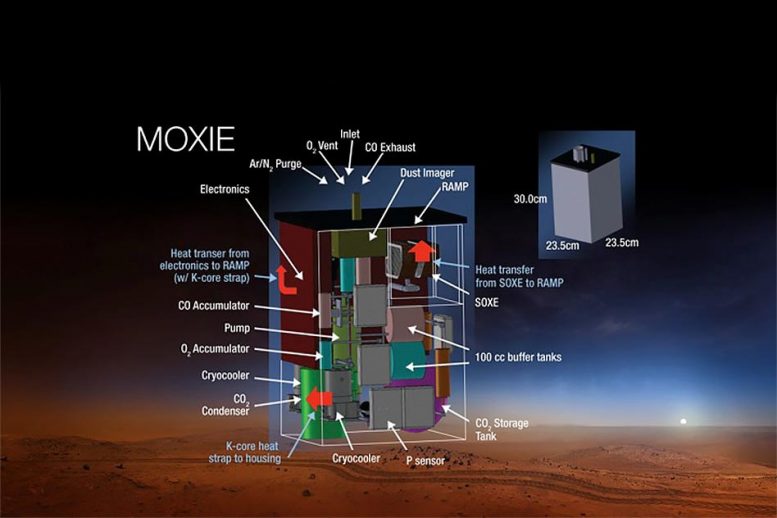Since reaching the Martian surface in February, NASA’s Perseverance mission has earned admiration for achieving feats that were only thought possible in science fiction, such as flying a helicopter there, which it did this week. The pioneering Mars rover has now added another feather to its cap.
The US space agency has announced that on Tuesday, a device aboard the rover was able to produce oxygen from the thin Martian atmosphere for the first time – a development that has brought cheer among the scientific community, as it promises hope for future crewed missions that can rely on this technology for astronauts to breathe and return to Earth.
How did Perseverance produce oxygen on Mars?
In its first operation since arriving on the Red Planet, the Mars Oxygen In-Situ Resource Utilization Experiment (MOXIE) produced 5 grams of oxygen from carbon dioxide in the Martian atmosphere, enough for an astronaut to breathe for 10 minutes.
On Mars, carbon dioxide makes up ~96% of the gas in the planet’s atmosphere. Oxygen is only 0.13%, compared to 21% in Earth’s atmosphere. Like a tree on Earth, MOXIE inhales carbon dioxide and exhales oxygen.
To produce oxygen, MOXIE separates oxygen atoms from carbon dioxide molecules. It does so by using heat at a temperature of around 800 degrees Celsius, and in the process also produces carbon monoxide as a waste product, which it releases in the Martian atmosphere.
A technology demonstrator, MOXIE is designed to generate up to 10 grams of oxygen per hour, and is placed inside the Perseverance rover. It is the size of a car battery, weighing 37.7 pounds (17.1 kg) on Earth, but just 14.14 pounds (6.41 kg) on Mars.
Through its first successful run, MOXIE was able to demonstrate that it survived its launch from Earth, an almost seven-month journey through deep space, and landing on the Martian surface with Perseverance. Over the next two years, MOXIE is expected to extract oxygen nine more times.
MOXIE is only a test model. Future oxygen generators that descend from its technology need to be about 100 times larger to support human missions on Mars.
But, why is producing oxygen on the Red Planet so important?
A substantial amount of oxygen supply on Mars is essential for crewed missions that plan to go there– not just for astronauts to breathe but for rockets to use as fuel while coming back to Earth.
As per the NASA press release, for four astronauts to take off from Mars, a future mission would require around 7 metric tons of rocket fuel and 25 metric tons of oxygen– around the weight of an entire space shuttle. In contrast, astronauts living and working on Mars would require far less oxygen to breathe, maybe around one metric ton.
Scientists believe that it will be an enormous challenge to haul the 25 metric tons of oxygen from Earth to Mars for the return journey, and that their job would become significantly easier if the liquified oxygen can be produced on the Red Planet. This is where MOXIE’s role comes in.
“When we send humans to Mars, we will want them to return safely, and to do that they need a rocket to lift off the planet. Liquid oxygen propellant is something we could make there and not have to bring with us. One idea would be to bring an empty oxygen tank and fill it up on Mars,” said Michael Hecht, MOXIE’s Principal Investigator.
NASA hopes to build a larger technological descendant of the experimental MOXIE that can do this job. A one-ton oxygen converter of this kind would be much more economical and practical to take to Mars, instead of 25 metric tons of oxygen, the agency argues.
Jim Reuter, associate administrator for NASA’s Space Technology Mission Directorate (STMD), called MOXIE’s feat “a critical first step at converting carbon dioxide to oxygen on Mars”.
“MOXIE has more work to do, but the results from this technology demonstration are full of promise as we move toward our goal of one day seeing humans on Mars. Oxygen isn’t just the stuff we breathe. Rocket propellant depends on oxygen, and future explorers will depend on producing propellant on Mars to make the trip home.”











0 Comments